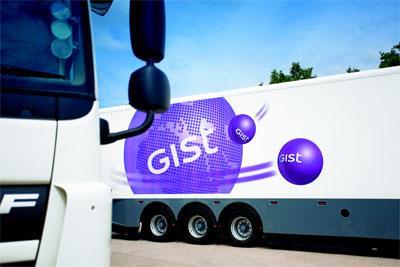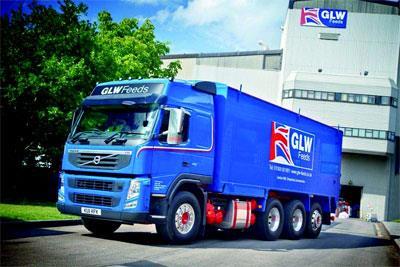
Gist
Gist conducts more than 5,000 vehicle movements a week for grocery retailers, moving £4bn of stock – £2bn of which has less than three days of shelf life. This results in some complicated vehicle scheduling, particularly as 40% of orders are scheduled after a vehicle has started its journey.
The operator asked itself the question: “How can I best use my network of vehicles, subcontractors and cross-dock locations to effectively move every consignment from factory to destination in the allowed window?”
The answer was Gist DXS. The software system, an in-house development, essentially conducts a reverse auction of combinations of vehicles, warehouses and customers across two trillion routeing combinations. This achieves the lowest total cost for moving goods across Gist’s network.
Since its deployment, GistDXS has scheduled more than 50 million kms and ensured uninterrupted service through key periods, including Christmas. Gist’s central logistics team uses the software to plan its UK primary distribution network – making choices that are not immediately apparent to a route planner. Gist maintains an on-time-into-depot KPI of 85% against a 15-minute window in fleet that covers more than one million kms a week.
One judge said: “An impressive use of stats on the size, scale and complexity of the task.” Another singled out a “good use of technology
in a difficult operation”.
James Jones & Sons

Timber haulier James Jones has to run its fleet for sustained periods on rural roads. These roads face heavy use and deteriorate as they were designed for 38-tonne vehicles, not 44-tonners. This situation is perpetuated in periods of bad weather. Local authorities place restrictions regarding set tonnage on roads; the number of vehicles per day that can use a road and set periods of the year where haulage can take place.
All these factors restrict the availability of raw materials to James Jones’s customers – so the company introduced the Tireboss tyre-pressure control technology (TPC) on its fleet. TPC allows a truck driver to deflate and inflate tyres on the wagon to a set pressure – depending on whether the vehicle is loaded or unloaded; what the speed the vehicle needs to move at and what the condition of the road is.
The Tireboss system is widely used in Canada and benefits include increased traction, increased tyre life and reduced road costs and maintenance. And fuel savings as a result of TPC are between 3% and 6% and noise pollution is reduced through decreased vibration.
The judges said: “A niche market requires a niche solution – and this is it!” Another said: “A simple solution, but very effective and good for the environment.”
GLW Feed

Despite an increasing tonnage of animal feed being delivered to farms by road, the access infrastructure in the majority of farms has not been updated at the same pace as animal husbandry and feed technology has.
The need for feeds means that suppliers now have to use 32-tonne GVW eight-wheelers, rather than the more manoeuvrable 26-tonne GVW six-wheeler – that has a smaller wheelbase. It is a catch-22: customers need increased delivery quantities, while access to silos is poor at the delivery point. This has led to an increase in delivery frequency.
GLW Feed approached specialist animal feed bodybuilder Priden Engineering, alongside Volvo, to develop a bespoke solution. A Volvo FM8x4 chassis was equipped with a hydraulically steered lifting axle behind the rearmost drive axle. This gives the appearance of a four-axle rigid with three air-suspended axles at the rear, instead of the front two axles being on a steel suspension arrangement as in a conventional eight-wheeler. It has a wall-to-wall turning circle of 12.5m, compared to a conventional 8x4 turning circle of 21m.
The Volvo Tridem can carry 18,600kg. Now a farmer who would have taken 15 tonnes of animal feed, can have 18 tonnes delivered at less frequent intervals. It reduces the number of deliveries made and helps with cash flow.
Judges said the system was very practical with benefits to customer and operator, and was a unique problem with a unique solution. They said it was good evidence of specific outcomes for operator and customer improved productivity across both businesses.
Palletways

Palletways faced a problem: its network volumes were increasing and it needed to improve the quality of its data capture. Traditionally, manual scanning is used to capture information – but this increases the chances of human error and there are no means of capturing and viewing information on the condition of individual pallets.
Palletways consulted with its network members and their customers to solve the problem: it needed to improve scanning accuracy to know the exact location of each pallet at all times; to be able to view the condition of individual pallets; to improve the speed and accessability of information; and to resolve handling issues and minimise loss and damage.
Palletways spent £750,000 on developing the technology. The Palletways Archways Scanning System (PASS) uses a network of scanners and HD cameras to photograph every vehicle and individual pallet coming through its warehouse. It integrated PASS into its web portal PORT providing instant access to this information through any device connected to the internet. It has led to a 23% improvement in pallets per shift per full-time employee; a 6% reduction in the direct cost per pallet; a 1.5 percentage point increase in network service performance, and £2m of new business won in 2012 so far.
Judges said: “Excellent submission. Well targeted.” “It has led to benefits that are sold to customers.” “Fantastic results, impressive.”











